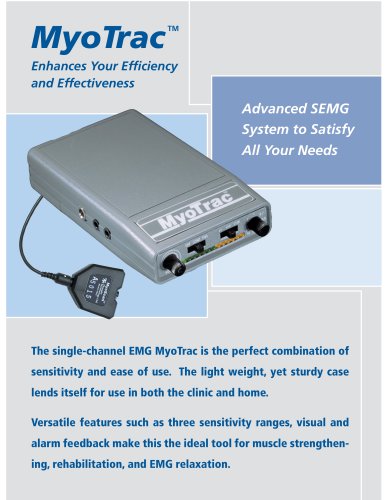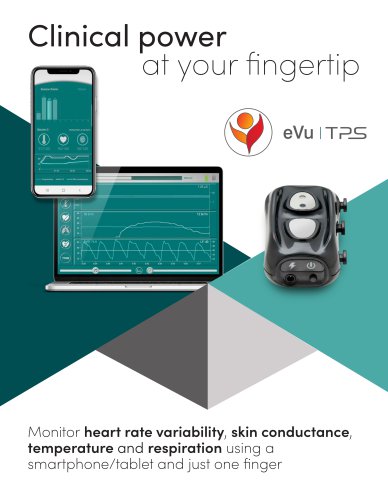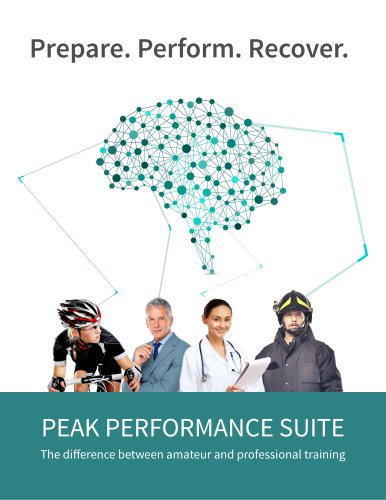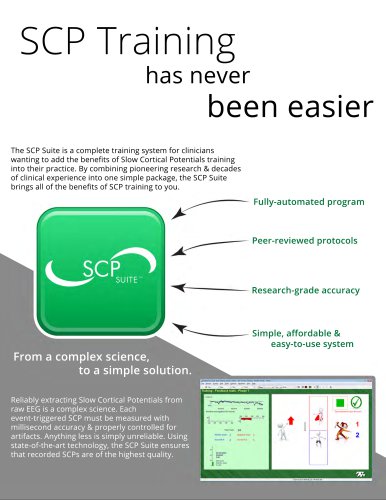 Website:
Thought Technology
Website:
Thought Technology
Catalog excerpts

Product Information Sheet – SCP Suite What are Slow Cortical Potentials? Slow Cortical Potentials, or SCPs, are very slow, event-related shifts of the EEG. Unlike the spontaneous, oscillatory activity of higher frequency brain waves traditionally used in Neurofeedback (e.g. Delta, Theta, Alpha & Beta), SCPs are in the range of 0-1 Hz, with 0Hz representing the DC baseline of the EEG signal. SCPs are best captured using protocols comprising discrete, time-locked events, with measurements of low frequency EEG initiated by an external stimulus such as a tone or visual presentation, and lasting up to 8 seconds. While the actual physiological source of SCPs is still a topic of debate, they are considered to be a consequence of synchronous activity of large cell assemblies which are responsible for the initiation of goal directed behavior. The clinical program on which the SCP Suite is based describes a three-phase protocol used to teach clients to voluntarily increase or decrease cortical potentials 1,2. It has been demonstrated that negative shifts of potential represent cortical activation and positive shifts represent cortical inhibition. Cortical activation is related to an increase of physiological resource allocation and favors such processes as attention and cognitive function. Cortical inhibition, on the other hand, is linked to the reduction of cortical excitation, leading to a calming of mental processes. In general, training to voluntarily generate negative or positive shifts of SCP levels helps your clients by improving their self-regulation capabilities. The Slow Cortical Potential Suite The SCP Suite (SA7985) was designed based on the original SCP research from the University of Tubingen, Germany. Inspired by the work of Ute Strehl & Neils Birbaumer on clinical SCP1,2, it includes everything you need for SCP (Slow Cortical Potential) training. Positive and negative SCPs are trained consecutively in a fully automated scripted session. The feedback includes carefully selected animations, which provide pleasing instructions & feedback on the SCP required. The suite also takes advantage of the full power of BioGraph Infiniti, by using Quick Start favorites, which allow you to start a scripted session and review, report and analyze statistics with the click of a single button or even a desktop shortcut.
Open the catalog to page 1
• Direct implementation of the clinical protocol developped by Ute Strehl1’2 • Quick Start Favorites are pre-defined for you. Start a session & review with a single click. Even from a desktop icon! • Quick, easy interface for SCP training. Simply start a script, and follow the indications. • Feedback training using positive and negative SCPs. • Transfer trials for real-world transfer of learned SCP training. • Artifact correction using dedicated EEG sensor for eye-movement detection. • Feedback tools include specially selected animations in both single & dual screen configurations. • Simple...
Open the catalog to page 2
Screens overview Artifact calibration using EEG-Z sensor Feedback screen using custom animations Transfer trial screen using custom animations
Open the catalog to page 3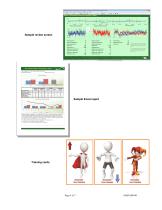
Sample review screen Sample Excel report Training cards
Open the catalog to page 4
What does the Suite include and how to use it? This SCP Suite will allow the user to perform time-locked SCP training using a predefined trial structure. The program is composed of the following 3 phases of training: Phase 1 is composed of four runs of 40 trials, each being composed of a rest, baseline and 8s trial equally distributed between negative and positive Slow Cortical Potentials. In Run 3, ten of the trials are transfer trials. Phase 2 is also composed of four runs of 40 trials each being composed of a rest, baseline and 8s trial equally distributed between negative and...
Open the catalog to page 5
A desktop shortcut to the folder called “SCP Suite favorites" is created, which includes 9 Quick Start Favorites: • SCP - Practice • SCP - Training • SCP - Training • SCP - Training • SCP - Training • SCP - Training • SCP - Training • SCP - Training • SCP - Training Feedback trials - Phase 1 - 1 monitor Phase 1 - 1 monitor Phase 1 - 2 monitors Phase 2 - 1 monitor Phase 2 - 2 monitors Phase 3 (neg bias) - 1 monitor Phase 3 (neg bias) - 2 monitors Phase 3 (pos bias) - 1 monitor Phase 3 (pos bias) - 2 monitors With these screens and...
Open the catalog to page 6
Sensor/Channel Reference Table: Input Encoder ProComp Infiniti TT-AV SYNC U. (2009). Slow cortical potentials neurofeedback. Journal of Neurotherapy, 13(2), 117-126. Strehl et al. (2006) Self-regulation of slow cortical potentials: a new treatment for children with attention-deficit/hyperactivity disorder. Pediatrics. 118(5):e1530-40.
Open the catalog to page 7All Thought Technology catalogs and technical brochures
-
MyoTracTM
2 Pages
-
Prepare. Perform. Recover
4 Pages
-
SCP Training
2 Pages
-
BioGraph
2 Pages
Archived catalogs
-
why buy infiniti
2 Pages
-
ProComp Infiniti
2 Pages
-
continence brochure
3 Pages
-
TPS Destress
2 Pages
-
MyOnyx
2 Pages
-
U-Control
2 Pages
-
EEG-Z
1 Pages
-
developer tools
2 Pages
-
biograph infiniti software
2 Pages
-
infiniti brochure
2 Pages
-
procom2
2 Pages
-
ProComp5 infiniti
1 Pages
-
myoTrac infiniti System
4 Pages
-
Rehab suite with myoTrac 3
2 Pages
-
EEG & physiology suite
2 Pages
-
Pro/flex series
1 Pages
-
CardioPro Infiniti
3 Pages
-
TT-pIR system
2 Pages
-
reaction time suite
3 Pages
-
Z-score 6
2 Pages
-
stress suite
2 Pages
-
HRV suite
2 Pages
-
BIOGRAPH INFINITI 6
3 Pages


